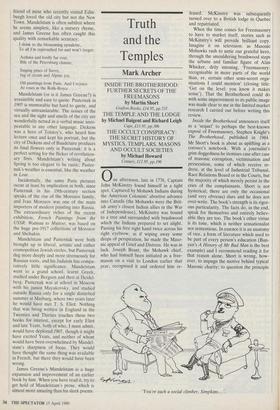Truth and the Temples
Mark Archer
INSIDE THE BROTHERHOOD: FURTHER SECRETS OF THE FREEMASONS by Martin Short
Grafton Books, £14.95, pp.531
THE TEMPLE AND THE LODGE by Michael Baigent and Richard Leigh
Cape, £13.95, pp.306
THE OCCULT CONSPIRACY: THE SECRET HISTORY OF MYSTICS, TEMPLARS, MASONS AND OCCULT SOCIETIES by Michael Howard
Century, £12.95, pp.I96
0 ne afternoon, late in 1776, Captain John McKinstry found himself in a tight spot. Captured by Mohawk Indians during the American Colonists' abortive advance into Canada (the Mohawks were the Brit- ish army's closest Indian allies in the War of Independence), McKinstry was bound to a tree and surrounded with brushwood which the Indians prepared to set alight. Passing his free right hand twice across his right eyebrow, as if wiping. away some drops of perspiration, he made the Maso- nic appeal of Grief and Distress. He was in luck. Joseph Brant, the Mohawk chief, who had himself been initiated as a free- mason on a visit to London earlier that year, recognised it and ordered him re-
leased. McKinstry was subsequently turned over to a British lodge in Quebec and repatriated.
When the time comes for Freemasonry to have to market itself, stories such as McKinstry's will provide brilliant copy. Imagine it on television: as Masonic Mohawks rush to untie our grateful hero, through the smouldering brushwood steps the urbane and familiar figure of Alan Whicker, drily intoning, 'Freemasonry: recognisable in more parts of the world than, er, certain other semi-secret orga- nisations I could mention' (closing title: `Get on the level: you know it makes sense'). That the Brotherhood could do with some improvement to its public image was made clear to me in the limited market research I carried out before writing this review.
Inside the Brotherhood announces itself as a 'sequel' to perhaps the best-known exposé of Freemasonry, Stephen Knight's The Brotherhood, published in 1984. Mr Short's book is about as uplifting as a coroner's notebook. With a journalist's grim doggedness he itemises case after case of masonic corruption, victimisation and persecution, some of which receive re- dress, at the level of Industrial Tribunal, Race Relations Board or in the Courts, but the majority of which merely persist in the cries of the complainants. Short is not hysterical; there are only the occasional (and very obvious) slurs and he does not over-write. The book's strength is its rigor- ous particularity. The facts do, in the end, speak for themselves and entirely believ- able they are too. The book's other virtue is its tone, which is neither sensationalist nor sententious. In essence it is an anatomy of vice, a form of literature which used to be part of every person's education (Bun- yan's A History of Mr Bad Man is the best example) and I recommend reading it for that reason alone. Short is wrong, how- ever, to impugn the motive behind typical Masonic charity; to question the principle 'You're such a social climber, Simpkins...'. of providing for one's own, or the fact that the Royal National Lifeboat Institute, a chief beneficiary, shares the Duke of Kent as its patron, takes Short beyond what he can legitimately say. The question whether these particular instances of corruption, convincing as they are, serve as an indictment of Freemasonry in general, or whether the institution by its nature is liable to foster them, is impossible to answer. A mason's oath of loyalty to fellow masons before all else is taken alongside pledges of equal vehemence to observe the law and not seek self- preferment through membership. For my- self, the idea of spending an evening dressed up in an apron, swearing oaths about having one's tongue cut out, or acting out the symbolic death and resurrec- tion of Hiram Abiff (the Biblical First Mason) is without meaning. The ideals to which Freemasonry aspires are as liable to perversion in practice as those which in- form many a human association, but they are no less real for that. Where they are seen to fail, it seems to me to be because for most men, as T. S. Eliot was fond of saying, it is the spirit which killeth, where- as the letter giveth life.
To read Michael Baigent and Richard Leigh's history of Freemasonry, The Tem- ple and The Lodge, is in part to be reminded of this spirit. The book is fasci- nating for the detective work the authors do to authenticate the long-held legend of Freemasonry as originating with the flight after 1309 of the Knights Templars from Europe to the protection of the excom- municate Scottish King Robert Bruce. The book begins with an eerie' and beautiful account of their discovery of long-lost Templar graves on the island of Kilmartin in Lock Awe in the West of SCotland, after which they follow the Templar heritage through a network of noble Scottish fami- lies leading to its identification with the Stuart cause. Separation from the cause seems to have been made official by the establishment of the English Grand Lodge two years after the Scottish rebellion of 1715. The argument that the 'universal' virtues of egalitarianism and tolerance fostered by Freemasonry helped England to lose the American War of Independence is perhaps the biggest conspiracy theory of all, but it is persuasively argued.
Michael Howard's kaleidoscopic The Occult Conspiracy lumps Freemasonry along with other, more overtly cranky, attempts to perceive 'the spiritual reality beyond the physi-Ri world'. My impression is that the author is far wiser than the Glastonbury-and-Sandals presentation of this book makes him sound. It successfully confirms that the nearer one approaches to truth, the more its caricatures abound. Perhaps it is only in places of such myste- rious stillness as the church of St Stephen, Walbrook (built to mystical proportions by Grand Mason Wren) that they are banished forever.



















































 Previous page
Previous page